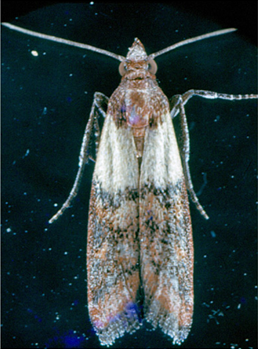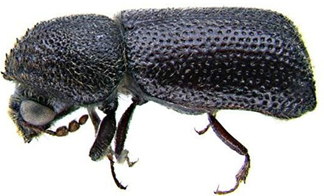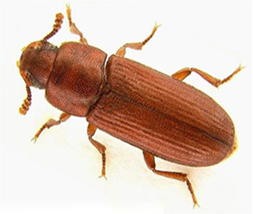Insects - finger millet
Contributors to this page: ICRISAT, Patancheru, India (RP Thakur, AG Girish, VP Rao).
|
Contents: |
Scientific name
Plodia interpunctella Hubner.
Other scientific names
Not known
Importance
Medium
Significance
Indian Meal Moth is a common grain-feeding pest. It can infest a variety of products and is perhaps the most economically important insect pest of processed food. Infestations of P. interpunctella can cause direct product loss and indirect economic costs through pest control costs, quality losses, and consumer complaints (Phillips et al. 2000).
Symptoms
Plodia interpunctella is an external feeder. The larvae continuously spin a silken web both inside and on top of the grain surface, and feed within the web. The webbing contains larval excreta (frass) and exuvia (cast skins), and gives an unpleasant odor to the infested commodity. The infested commodity is sometimes covered on the surface with a thick mat of silken webbing (Mohandass et al. 2007).
Biology and transmission
Female moths lay between 60 and 400 eggs (Lyon 1991) on a grain surface, which are ordinarily smaller than 0.5 mm and not sticky. The eggs hatch in 2 to 14 days. The moth larvae are off-white with brown heads. When these larvae mature, they are usually about 12 mm long. The larval stage lasts from 2 to 41 weeks, depending on the temperature. Adult moths are 8–10 mm long with 16–20 mm wingspans. The outer half of their forewings are bronze, copper, or dark gray in color, while the upper half are yellowish-gray, with a dark band at the intersection between the two. The entire life cycle may range from 30 to 300 days (Mohandass et al. 2007).
 Indian Meal Moth (Plodia interpunctella) of finger millet (photo: ICRISAT). |
Hosts
Arachis hypogaea (groundnut), Oryza sativa (rice), Prunus (stone fruit), stored products (dried stored products), Triticum aestivum (wheat), Zea mays (maize), Avena sativa (oats), Corylus, Helianthus annuus (sunflower), Hordeum vulgare (barley), Juglans regia (Carpathian walnut), Pistacia vera (pistachio), Prunus dulcis (almond) and Theobroma cacao (cocoa).
Geographic distribution
Plodia interpunctella is cosmopolitan in distribution especially in warm climates. In cool temperate countries, it can survive in heated buildings.
Detection/indexing methods
- The primary detection method is through pheromone-based trapping of males (Phillips et al. 2000). The pheromone commonly referred to as ‘‘ZETA’’ was one of the first commercial pheromones for stored-product insects, and the response of males to this pheromone has been well documented.
Treatment/control at ICRISAT
- Fumigation with methyl bromide @ 32 g/m3 for 4 hr followed by seed treatment with chlorpyriphos at 3 g kg-1 seed (Ghanekar et al. 1996; Toews et al. 2006).
Procedures followed in case of positive test at ICRISAT
- Infested samples are rejected in case of positive test.
References and further reading
Chakrabarty SK, Anitha K, Girish AG, Sarath Babu B, Prasada Rao RDVJ, Varaprasad KS, Khetarpal RK, Thakur RP. 2005. Germplasm exchange and quarantine of ICRISAT mandate crops. Information Bulletin No. 69. Rajendranagar 500 030, Andhra Pradesh, India: National Bureau of Plant Genetic Resources; and Patancheru 502 324, Andhra Pradesh, India: International Crops Research Institute for the Semi Arid Tropics. 80pp.
Ghanekar AM, Ranga Rao GV, Murthy KS, Surender A, Shaik Babu Saheb. 1996. Seed protectants for healthy exports. Indian Journal of Plant Protection 24: 37-43
Lyon WF. 2006. Ohio State University Extension Fact Sheet. Entomology. Indianmeal Moth Ohio State University.
Mohandass S, Arthur FH, Zhu KY, Throne JE. 2007. Biology and management of Plodia interpunctella (Lepidoptera: Pyralidae) in stored products. Journal of Stored Products Research 43: 302-311.
Phillips TW, Berbert RC, Cuperus G.W. 2000. Post-harvest integrated pest management. In: Francis, F.J. (Ed.), Encyclopedia of Food Science and Technology. 2nd ed. Wiley Inc., New York, pp. 2690–2701.
Toews MD, Campbell JF, Arthur FH. 2006. Temporal dynamics and response to fogging or fumigation of stored-product Coleoptera in a grain processing facility. Journal of Stored Products Research 42:480-498.
Scientific name
Other scientific names
Dinoderus truncatus
Importance
High
Significance
The borer damages grains leading to significant weight loss (5-20%). The quantity of grain dust produced from 6 to 29 g kg-1 grain (Mailafiya 2008).
Symptoms
Adults frequently attack stored seed with intact sheaths by boring into the base of seed. Adults bore into the grains, making neat round holes, and as they tunnel from grain to grain they generate large quantities of grain dust. Adult females lay eggs in chambers bored at right angles to the main tunnels.
 Larger Grain Borer (Prostephanus truncatus) of finger millet (photo: www.agrsci.dk/). |
Hosts
Manihot esculenta (cassava), stored products (dried stored products), Zea mays (maize), Dioscorea (yam) and Triticum aestivum (wheat).
Geographic distribution
Prostephanus truncatus is indigenous in Central America, tropical South America, and the extreme south of the USA as a major pest. It is also distributed in Africa and Europe, but has restricted distribution in India.
Biology
The adult has the typical cylindrical bostrichid shape with body length of 3-4.5 mm. The declivity is flattened and steep and has many small tubercles over its surface. The limits of the declivity, apically and laterally, are marked by a carina. The antennae are 10-segmented and have a loose three-segmented club; the 'stem' of the antenna is slender and clothed with long hairs and the apical club segment is as wide as, or wider than, the preceding segments. The larvae are white, fleshy and sparsely covered with hairs. They are parallel-sided, i.e. they do not taper. The legs are short and the head capsule is small relative to the size of the body.
Detection/indexing methods at ICRISAT
- Pre-export field inspection and dry seed examination using magnifying lens.
Treatment/control
- Not known due to non-detection of the pest.
Procedures followed in case of positive test at ICRISAT
- Incineration of the infested seed samples.
References and further reading
Chakrabarty SK, Anitha K, Girish AG, Sarath Babu B, Prasada Rao RDVJ, Varaprasad KS, Khetarpal RK, Thakur RP. 2005. Germplasm exchange and quarantine of ICRISAT mandate crops. Information Bulletin No. 69. Rajendranagar 500 030, Andhra Pradesh, India: National Bureau of Plant Genetic Resources; and Patancheru 502 324, Andhra Pradesh, India: International Crops Research Institute for the Semi Arid Tropics. 80pp.
Mailafiya DM, Ayertey JN, Cudjoe AR. 2008.Damage and weight loss potential of Prostephanus truncatus (Horn) Coleoptera: Bostrichidae) on sorghum grain: implication to cereal grain storage in sub-Saharan Africa. International Journal of pure and applied sciences 2: 28-35.
Scientific name
Tribolium castaneum Herbst.
Other scientific names
Not known.
Importance
Medium
Significance
Important in stored finger millet grain in several countries.
Symptoms
Infestation by adult beetles can be readily observed by the tunnels they leave when they move through the flour and other granular food products. Damage is particularly serious in grains such as rice and wheat, which have either been dehusked or processed into other products. When infestation is severe, these products turn grayish-yellow and become moldy, with a pungent odor. Infestation may also be apparent by the appearance of adults on the surface of the grains (Teetes et al. 1983).
 Red Flour Beetle (Tribolium castaneum) of finger millet (photo: ICRISAT). |
Hosts
Arachis hypogaea (groundnut), Avena sativa (oats), Bertholletia excelsa (Brazil nut), Hordeum vulgare (barley), Juglans (walnuts), Lens (lentil), Oryza sativa (rice), Phaseolus (beans), Phaseolus lunatus (lima bean), Pisum sativum (pea), Prunus dulcis (almond), Secale cereale (rye), Triticum (wheat), Triticum spelta (spelt) and Zea mays (maize).
Geographic distribution
Tribolium castaneum is cosmopolitan in distribution. It is found in stored grain, seeds, flour, dried fruits and nuts in worldwide (Teetes et al. 1983).
Biology and transmission
The adult is 2.3-4.4 mm long, rather flat, oblong and chestnut-brown (reddish-brown). It lays about 450 eggs in stored produce. The eggs of are minute, cylindrical and white. The incubation period lasts for 5-12 days. The yellowish-white cylindrical grub is covered with fine hairs. The pupa is naked (without a cocoon), yellowish-white, becoming brown later, and adults emerge in 3-7 days (Teetes et al. 1983).
Detection/indexing methods at ICRISAT
- X-ray radiography is used for suspected samples because it offers a non-destruction of the seed. Dry seed examination using magnifying lens to separate the infested seed.
Treatment/control
- Fumigation of the samples with methyl bromide by 32 gm/m3 for 4 hr followed by treatment with chlorpyriphos 3g kg-1 seed (Ghanekar et al. 1996).
- Procedures in case of positive test at ICRISAT
- Infested samples are rejected.
References and further reading
Chakrabarty SK, Anitha K, Girish AG, Sarath Babu B, Prasada Rao RDVJ, Varaprasad KS, Khetarpal RK, Thakur RP. 2005. Germplasm exchange and quarantine of ICRISAT mandate crops. Information Bulletin No. 69. Rajendranagar 500 030, Andhra Pradesh, India: National Bureau of Plant Genetic Resources; and Patancheru 502 324, Andhra Pradesh, India: International Crops Research Institute for the Semi Arid Tropics. 80pp.
Ghanekar AM, Ranga Rao GV, Murthy KS, Surender A, Shaik Babu Saheb. 1996. Seed protectants for healthy exports. Indian Journal of Plant Protection 24: 37-43.
Teetes GL, Seshu Reddy KV, Leuschner K, House LR. 1983. Sorghum insect identification handbook. Information bulletin No.12. Patancheru, A.P., India: International Crops Research Institute for Semi-Arid Tropics. 125pp.
Comments
- No comments found





Leave your comments
Post comment as a guest